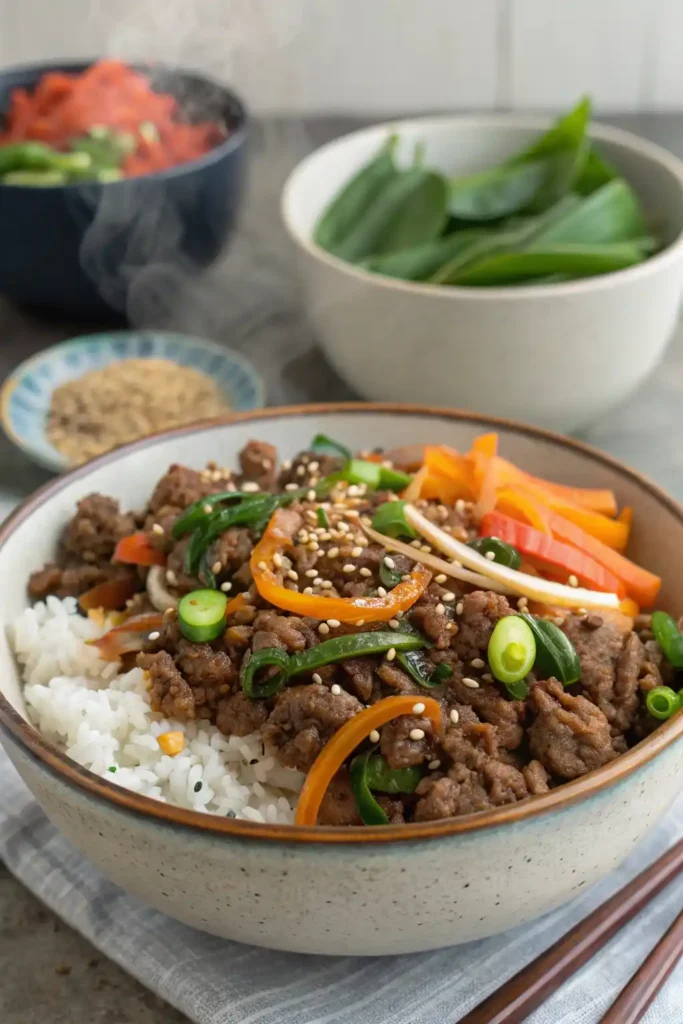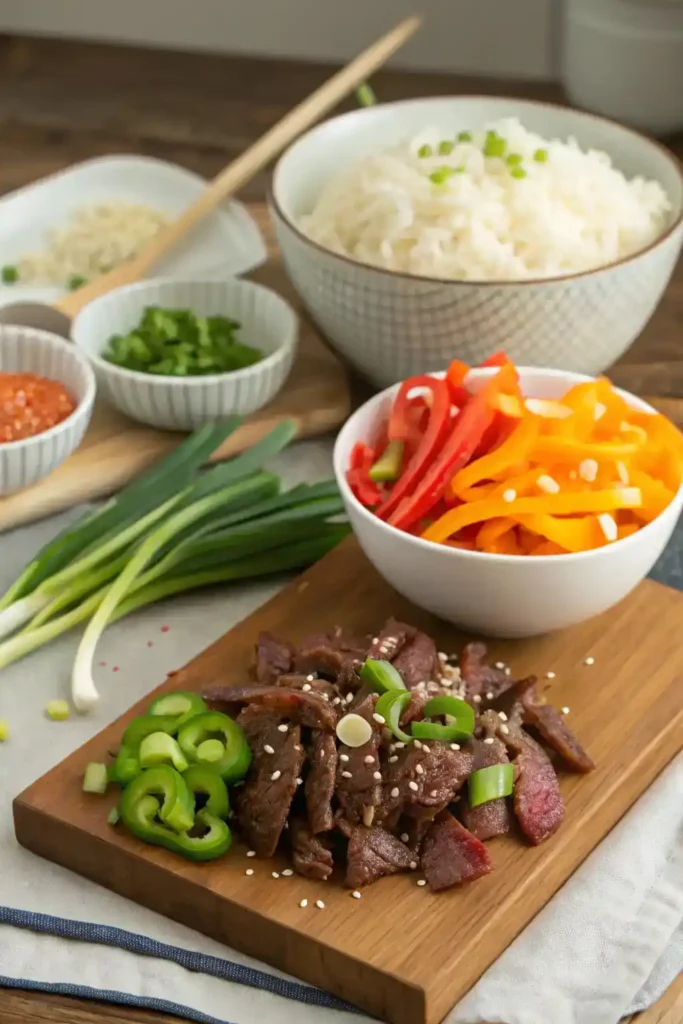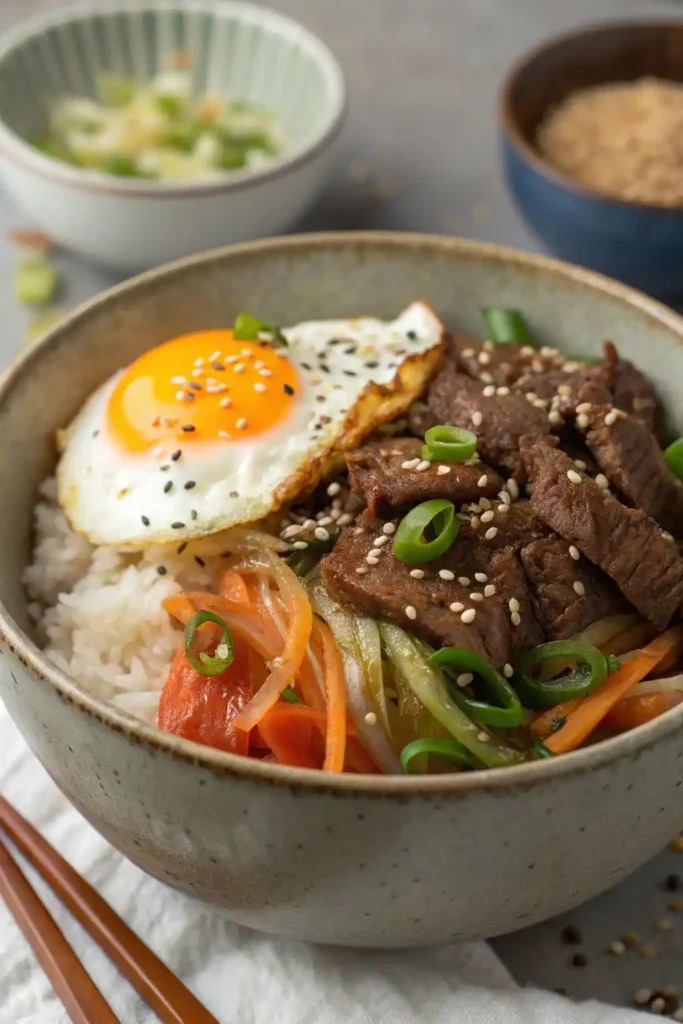A Korean beef bowl delivers dinner to your table in 20 minutes flat.
This satisfying homemade ground beef bowl beats takeout in both time and cost. The recipe yields 8 servings that work great for family dinners or meal prep. You’ll get 29g of protein in each bowl, along with authentic flavors from ginger, garlic, and sesame oil. The preparation stays simple despite its rich taste profile.
The recipe’s versatility makes it even better. You can mix in your preferred vegetables and tweak the sauce. Served over fresh rice, this 574-calorie meal will quickly become your weeknight go-to dish.
Let me show you how to create this simple yet flavorful Korean dish that brings authentic taste right to your kitchen.

Table of Contents
Essential Ingredients for Korean Beef Bowl
The perfect Korean beef bowl starts with the right ingredients. Each component plays a vital role in creating that signature Korean flavor balance.
Key Meat Options and Preparation
Ground beef forms the heart of this dish, with 93% lean ground beef being ideal. Ground turkey, chicken, or pork work great as alternatives. Your best bet is to grab freshly ground beef from the butcher’s meat trays instead of pre-packaged options.
Must-Have Sauce Components
A delicious Korean beef bowl sauce needs these key ingredients:
- Core Components:
- Low-sodium soy sauce
- Light brown sugar or honey
- Toasted sesame oil
- Fresh ginger and minced garlic
- Rice wine (different from rice vinegar)
Gochujang, a Korean chili paste, brings authentic depth and complexity to the sauce. Annie Chun’s Sweet and Spicy Gochujang Sauce can be found in your grocery store’s Asian section. On top of that, it helps to add crushed red pepper flakes to adjust the heat level.
Rice and Vegetable Selections
Korean beef bowls shine with their flexible base and vegetable options. Short-grain brown rice, white rice, or cauliflower rice make excellent foundations. Traditional Korean vegetables include:
Traditional Components:
- Spinach (seasoned with garlic and sesame oil)
- Bean sprouts
- Shredded carrots
- Sliced cucumbers
Mushrooms, bell peppers, or snow peas can boost both nutrition and texture. Green onions, sesame seeds, and a fried egg will give a beautiful finish and extra flavor.
Storage tip: Keep the beef mixture in separate airtight containers from vegetables. Everything stays fresh in the refrigerator for up to 4 days. The beef mixture freezes well up to three months if you’re planning ahead.
Note that authentic Korean beef bowls follow a bibimbap-style presentation, where vegetables sit in distinct sections around the rice bowl. This layout lets you appreciate each ingredient’s unique flavor contribution.

Making the Perfect Korean Beef Bowl Sauce
The secret behind an exceptional Korean beef bowl lies in its sauce – a harmonious blend of sweet, savory, and spicy elements that turns simple ingredients into a memorable meal.
Balancing Sweet and Savory Elements
Korean beef bowl sauce’s foundation starts with a precise ratio of soy sauce to sweetener. You’ll get optimal results by combining low-sodium soy sauce with brown sugar or honey in equal parts. Sesame oil’s nutty undertones add depth, then create a restaurant-quality taste. Rice wine vinegar adds a subtle tang that brightens the overall flavor profile.
Adjusting Heat Levels
This dish becomes versatile for every palate through heat customization. Gochujang, a traditional Korean chili paste, delivers both sweetness and moderate spiciness. New cooks should start with one teaspoon of gochujang and adjust the amount based on taste. These heat options work well too:
- Sriracha sauce for a straightforward heat
- Crushed red pepper flakes for subtle warmth
- Chili garlic sauce for garlicky spiciness
Quick Sauce Shortcuts
These time-saving techniques deliver consistent results:
- Simple Sauce Formula:
- Mix soy sauce, brown sugar, sesame oil, and minced garlic
- Add ginger and scallions (white parts only)
- Add your chosen heat element
If you have gluten sensitivity, tamari or coconut aminos work well instead of regular soy sauce. The sweetener should be reduced by one-third with gochujang since it contains natural sweetness.
Let the sauce simmer with the beef for 3-4 minutes until it thickens slightly. This brief cooking time helps the flavors blend perfectly without reducing too much. The sauce can be prepared separately and stored in an airtight container for meal prep convenience – it stays fresh for several days in the refrigerator.
The sauce should be tasted and adjusted before adding it to the beef. A perfect balance emerges when no single element overpowers the others. These simple yet precise techniques will help you create a sauce that matches your favorite Korean restaurant’s version.
Cooking Korean Ground Beef Step-by-Step
Becoming skilled at making Korean ground beef requires proper cooking techniques that lock in flavors and create the perfect texture.
Browning Techniques for Maximum Flavor
Heat a large cast iron skillet over medium-high heat. Add a light coating of vegetable oil when hot. Break the ground beef into small pieces and let it rest undisturbed for several minutes to achieve optimal browning. This vital step creates a rich, caramelized crust that makes the final flavor more intense.
Salt and pepper should season the meat while it cooks. The finely minced garlic and ginger go in after the original browning. Stir them constantly for about one minute until their aromatic oils release. You can boost the texture by pulsing the cooked beef 2-3 times in a food processor. This helps the sauce penetrate the meat better.
Combining Beef with Sauce
The skillet returns to medium heat after draining excess fat. The flavor-building stage happens next:
- Start with sesame oil to develop its nutty aroma
- The prepared sauce mixture goes in and comes to a gentle simmer
- Stir occasionally for 3-4 minutes until the sauce thickens and coats the beef
A slice of butter adds extra depth along with your choice of vegetables – this works especially when you have bell peppers. Let the mixture simmer until the sauce gets a glossy finish. The beef should develop slight caramelization in the final minutes.
Your perfectly cooked Korean ground beef should have these qualities:
- Even browning throughout
- Small, tender pieces that hold the sauce well
- A glistening appearance from the reduced sauce
- Rich aroma from the garlic, ginger, and sesame oil
The cooked beef mixture lasts in the refrigerator for 4-5 days. You can freeze portions up to three months in airtight containers. Add a splash of water while reheating to keep the sauce’s consistency right.
Assembling Your Korean Beef Rice Bowl
You can create restaurant-quality Korean beef bowls at home by mastering the art of layering that boosts both presentation and flavor. The right assembly techniques will help you build an amazing bowl.
Layering Components to Get Best Results
Start with a bed of steaming rice that fills about one-third of your bowl [link_1]. Place your seasoned Korean ground beef mixture among the rice, taking up another third of the space. This setup lets each ingredient keep its unique taste while they blend together perfectly as you eat.
Fresh Toppings and Garnishes That Make a Difference
Fresh toppings will lift your bowl’s nutrition and visual appeal. Here are some classic combinations that work really well:
- Core Vegetables:
- Carrots cut into thin strips with a peeler
- Crispy cucumber slices
- Sautéed mushrooms or bok choy
- Fresh spinach or mixed greens
A perfectly fried egg with a runny yolk makes a great protein-rich topping. Sprinkle some sesame seeds and freshly chopped green onions at the end.
Smart Storage for Meal Prep
Korean beef bowls make excellent prep-ahead meals. Here’s how you can store everything the right way:
- Component Storage:
- Your beef mixture stays fresh in airtight containers (lasts 4-5 days)
- Keep vegetables in separate containers to stay crisp
- Store rice with damp paper towels in its own container to keep moisture
Add a splash of water at the time of reheating. You can freeze the beef mixture up to 3 months. Pack beef and rice in one container for lunch, but keep fresh toppings separate until you’re ready to eat.
Put ingredients in meal prep containers right after cooking to keep everything fresh. Heat the beef and rice together in the microwave for one minute, then add 15-second bursts until it’s really warm.
Note that you can adjust portions based on your priorities – that’s what makes Korean beef bowls so great. These assembly tips will help you create delicious bowls whether you’re eating now or meal prepping for the week.

Conclusion
You can recreate authentic Asian cuisine at home with Korean beef bowls in just 20 minutes. This recipe brings restaurant-quality flavors to your dinner table through simple ingredients and proven techniques.
The secret to success lies in the sauce. A perfect balance of soy sauce, brown sugar, and aromatics creates that distinctive Korean taste. Your family will love how the perfectly browned ground beef and fresh toppings combine to deliver satisfying flavors and textures in each bowl.
This versatile dish works great for meal prep. Simply store the components separately and enjoy delicious, homemade Korean beef bowls throughout the week. The beef mixture stays fresh in the freezer for up to three months, which makes last-minute dinners easy.
Want to discover more quick and delicious recipes? Our website recipesnutritious.com offers plenty of meal ideas that blend convenience with authentic flavors. Note that great cooking doesn’t need complicated techniques or hard-to-find ingredients – simple recipes often become your family’s favorites.
FAQs
Q1. What are the key ingredients for a Korean beef bowl? The main ingredients include lean ground beef, garlic, ginger, brown sugar, soy sauce, sesame oil, and red pepper flakes. These are combined to create a flavorful sauce that coats the beef, which is then served over rice with optional toppings like green onions and sesame seeds.
Q2. How long does it take to make a Korean beef bowl? A Korean beef bowl can be prepared in about 20 minutes, making it an ideal quick dinner option. The beef cooks quickly, and the sauce comes together in minutes, allowing you to have a delicious meal on the table in no time.
Q3. Can I meal prep Korean beef bowls? Yes, Korean beef bowls are excellent for meal prep. The beef mixture can be stored in the refrigerator for 4-5 days or frozen for up to 3 months. For best results, store the beef, rice, and fresh toppings separately and assemble when ready to eat.
Q4. What vegetables go well with Korean beef bowls? Popular vegetable additions include sliced cucumbers, shredded carrots, sautéed spinach, and bean sprouts. You can also add bell peppers, mushrooms, or bok choy. These vegetables add freshness, crunch, and nutritional value to the dish.
Q5. How can I adjust the spiciness of my Korean beef bowl? The heat level can be customized by adjusting the amount of crushed red pepper flakes or gochujang (Korean chili paste) in the recipe. Start with a small amount and increase gradually to suit your taste preferences. You can also serve extra hot sauce on the side for those who enjoy more heat.

